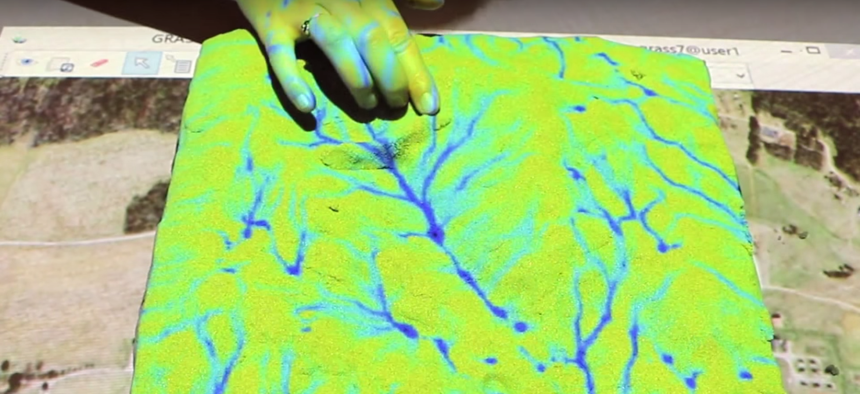Check Out The US Military's Sandbox of Silly-Putty That Predicts Disasters and War
Analysts are using what they call a ’tangible landscape' to predict the path of everything from forest fires and floods to movement of adversaries in war games.
The Defense Department is playing around with a shape-shifting, color-changing sandbox to limit the carnage from the next deadly flood, wildfire or other catastrophe.
That is the promise behind the "Tangible Landscape ."
Made up of kinetic sand, a toy that feels like the stuff on the beach but has the consistency of Silly Putty, the system's miniature bridges, lakes and other structures morph—or disappear—when a finger crushes critical infrastructure.
"Our goal is to provide planners with an intuitive, collaborative tool to design more resilient environments, identify and better understand where the critical, high-risk locations are," said Helena Mitasova, associate director of geovisualization at North Carolina State University.
NC State supplied the Tangible Landscape system that now sits inside the military’s spy mapping agency. The university's free GRASS computer program combines changes in the playdough with sets of geospatial data, like population density and pipeline locations, to predict a change’s influence on surroundings.
Mitasova’s comments came just as a cascade of crushing waters and broken gas lines was cutting-short 23 lives and devastating 1,200 homes in West Virginia.
The military’s National Geospatial-Intelligence Agency powered up a version of NC State’s Tangible Landscape about six months ago in its Springfield, Virginia-headquarters research lab, but the system is not being used for operations yet.
It’s expected that analysts there and federal partners will execute "what-if" scenarios, for everything from wargaming to predicting the path of a forest fire.
"Taking into consideration elevation and wind direction, wind speed... you can do a fire propagation scenario ," Joe Wileman, from the NGA research lab, told Nextgov .
The lab’s less-than $3,000 Tangible Landscape consists of the kinetic sand, a depth-sensing camera, and a color projector fueled by GRASS.
Responders to the inferno in central California that killed two people in recent days might have benefit from such a device, Mitasova said.
"We also aim at providing tools for training of first responders and educating the public about the spatial aspects of the disasters like flooding, storm surge or fire—people often don’t realize how widespread the impact can be, how even [a] small break in defenses far away can influence their location and how fast the situation can change," she said.
How it works : The camera scans the sandbox, then sends that imagery to a PC running the predictive analytics GRASS program. The software munches on the new imagery created by your finger depression and generates a new image that factors in variables like water flow and temperature. That output is sent to the projector, which then colors in a new picture on the sandbox.
"The computer is processing the relative elevation change and then broadcasting back a color-shaped image that is overlaid on top of the sand, and it's also putting in contour lines," explains an NGA researcher who spoke on background.
A reporter punches a hole in a dam. The system updates the model to cast a blue light seeping from the point of compression outward over what was previously green land and gray buildings.
This is the kind of simulation technology that might have come in handy during and after Hurricane Katrina in 2005.
"If we had a model of the city of all the dikes and levees, we could break the dikes and levees that broke during Katrina and we could show how the city was flooded," another NGA researcher said on background.
Light-table technology dates back about a decade, but NGA chose NC State's newer version because it allows you to insert data feeds in real-time.
The university and N.C.-based Fort Bragg, the largest Army installation in the world, already are putting one sandbox to use.
NC State researchers in 2010 postulated the Tangible Landscape might help the military base with land preservation .
Now, the school and Fort Bragg are mulling how to use the device for predicting sediment erosion and what its impact might be on the mussel habitat there, Mitasova said.
The spy cartographers likely will be paying attention to the Army’s land management project.
"We're just now toying with the operational capabilities of this, from the NGA perspective," Wileman said.
After rushing waters that killed nine soldiers at Fort Hood "in Texas and now West Virginia, we are even more motivated to work on our system and collaborate with the researchers at DOD on bringing it to users," Mitasova said.
NEXT STORY: OPM Updates Data Breach Information Website




